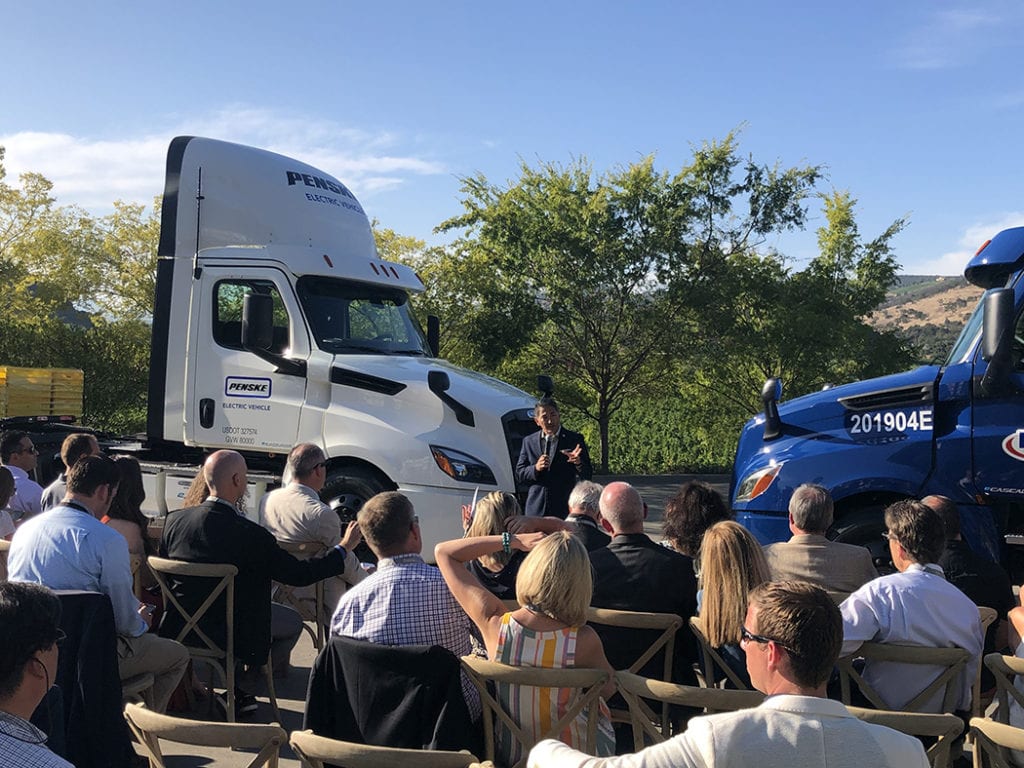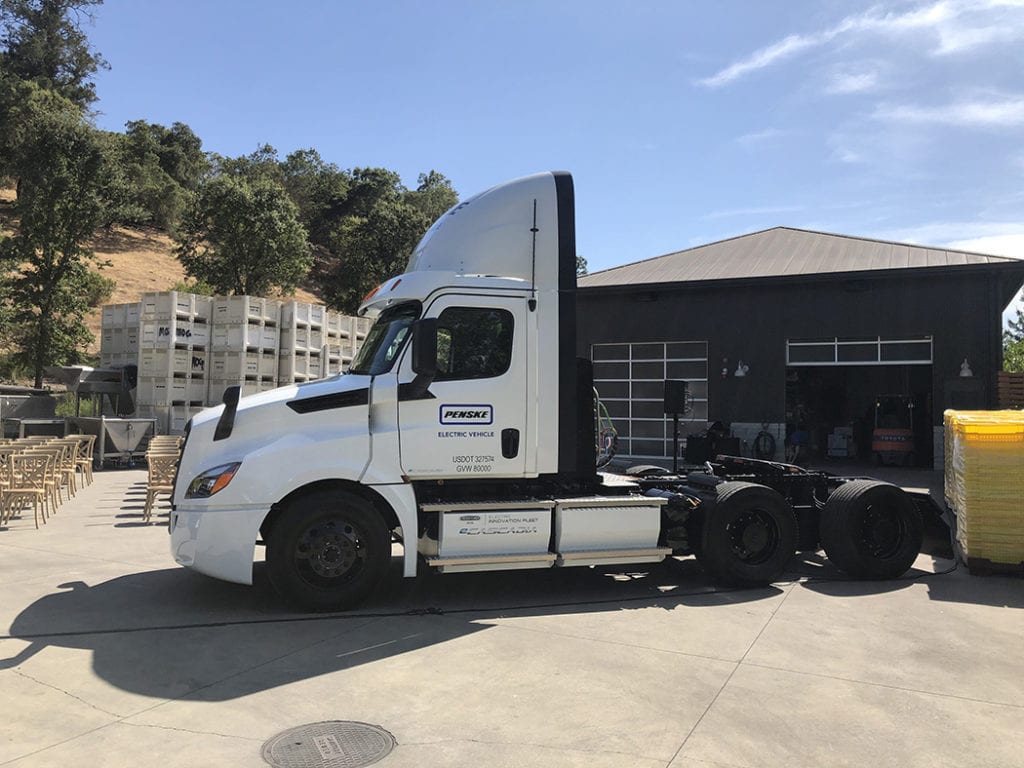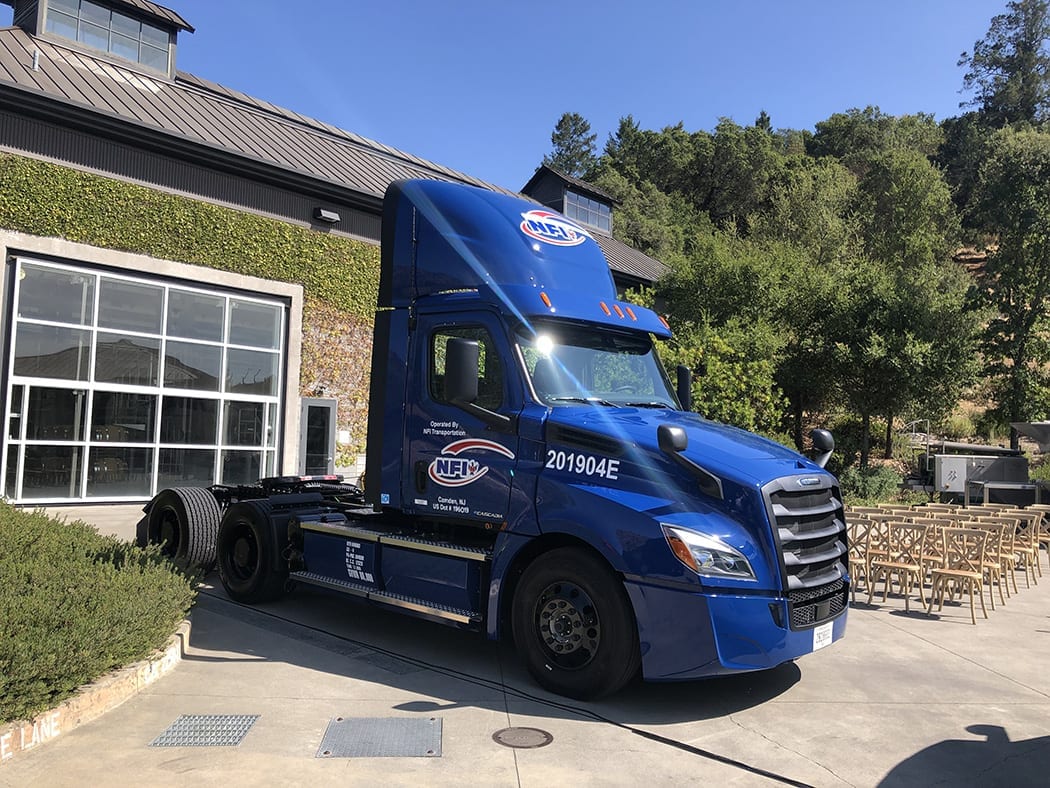Last week, Daimler Trucks North America delivered its first two Freightliner eCascadia Class 8 trucks to customers Penske Truck Leasing and NFI, marking the first Daimler heavy-duty electric vehicles to be put into fleet operation. Both customers will be using the vehicles to test the integration of battery electric trucks in their respective Southern California fleet operations.
The project partners convened at the Cliff Lede Winery in Napa to celebrate Daimler’s impressive achievement and industry milestone. It was especially significant to attend, as Gladstein, Neandross & Associates (GNA) has independently worked with each project partner, Daimler, Penske, NFI, and South Coast Air Quality Management District, to promote advanced, clean transportation initiatives for decades. Seeing, firsthand, North America’s leading heavy-duty truck manufacturer deliver zero emission vehicles to two prominent fleets was an incredible milestone.
Daimler’s eCascadia trucks will soon be going to work in Southern California’s busy freight sector, running routes in the very conditions they are meant to test—heavy traffic, unpredictable wait times, and demanding daily routes. The trucks will be collecting significant vehicle and driver experience data, invaluable to testing and proving commercial electric vehicle readiness.

Matt Miyasato, South Coast AQMD, speaks to the importance of Daimler’s milestone in reaching South Coast AQMD’s clean air goals.
Electric Innovation Fleet
This milestone is the first of many deliveries. Penske and NFI will receive a total of 30 battery electric trucks as part of Freightliner’s Electric Innovation Fleet. With support from GNA, Daimler received a $16 million grant from South Coast AQMD to launch the Freightliner Electric Innovation Fleet, a demonstration project with the goal to develop and deploy battery-electric trucks to commercial fleets.
The vehicles, operating in real-world conditions across California’s South Coast Air Basin, will be helping to achieve South Coast AQMD’s air quality goals by reducing tailpipe emissions while running actual routes.
Just fourteen months after announcing plans to develop a Class 8 electric truck, Daimler is delivering real trucks for real applications. NFI’s electric truck will run drayage operations at the San Pedro Bay Port Complex and Penske will be running daily delivery operations throughout Southern California’s Inland Empire. In total, the project funds 20 Class 8 eCascadias and 10 Class 6/7 eM2 prototypes, to be deployed in 2019, along with their charging infrastructure.
Working Alongside Customers
Daimler is leading the charge with insight and feedback gathered from working alongside fleet customers, starting at the initial design phase. Their Electric Vehicle Council, a group of 38 companies, was specifically created to test technology and develop solutions to the unique challenges of implementing commercial electric vehicles. Daimler’s holistic co-creation approach goes beyond the vehicle itself to address the entire ecosystem needed to support, maintain, and meaningfully scale medium and heavy-duty truck electrification.

Daimler delivered its first two Freightliner eCascadia Class 8 trucks to customers Penske Truck Leasing and NFI, marking the first Daimler heavy-duty electric vehicles to be put into fleet operation.
An Important First Step
These first pilot trucks are an important first step in a longer journey. Over the next few years, demonstration projects will play a key role in the future commercialization of battery electric trucks, allowing both OEMs and customers to more fully understand how electric trucks perform in various duty cycles. Demonstrating a lower total cost of ownership (TCO) is the ultimate requirement of this technology, which is no small task given the various number of hurdles that must be overcome by the electric truck industry.
As Roger Nielsen noted in his ACT Expo 2019 keynote address, three critical improvements must be realized before battery electric trucks can be a viable economic choice for customers: 1) the cost of the batteries must be cut in half; 2) the energy density of batteries must double; and 3) the size of the batteries must be cut in half. Of course, these significant improvements must be realized simultaneously in addition to a range of other challenges faced by the industry.
Electric fleets will require access to sufficient public and private charging infrastructure, favorable utility rate structures, a newly trained and highly skilled workforce, and a comprehensive support network capable of serving electric vehicles. Additionally, entirely new tools and services will need to be created to provide fleets with the ability to visualize, manage, and optimize their charging infrastructure in real time with their business needs.
This landmark project is critical to gaining insights into electric vehicle operation and performance under real-world range, weight, and route requirements. Concurrently, the project partners will gain a tremendous amount of insight into a wide range of other factors which will all prove critical to demonstrating the use case and TCO for heavy-duty electric trucks. All of this information will be important to informing the timing and scalability of this technology. Daimler’s delivery this week is an important milestone in this forward journey to testing, proving, and scaling commercial electric trucks.



